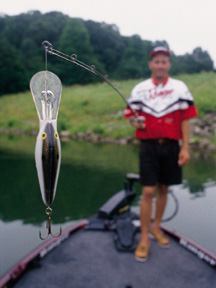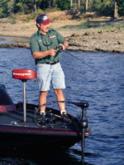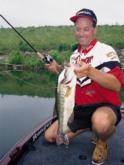Outdistancing the competition

Want your crankbaits to be more effective? Here’s the long and short of how to do it.
More than a decade has passed since David Fritts began tearing up the Red Man Tournament Trail with deep-diving crankbaits. The capable North Carolinian has since cranked his way to bass fishing fame and fortune. Along the way, he revolutionized the way anglers use crankbaits to fish for bass. Among his many innovations is the long, limber fiberglass rod that slings crankbaits a mile, allows the lures to dive deeper and increases the strike-to-catch ratio over shorter, stiffer rods.
Today it is no coincidence that the standard deep-cranking rod for many successful tournament anglers is 7 feet long, the length Fritts favors. But competitive anglers continually push the envelope, trying to take fishing techniques to the next level. Such is the case with Virginia angler Curt Lytle, who has found success in EverStart Series and Wal-Mart FLW Tour events.
While pre-fishing for a Red Man tournament on Kerr Reservoir a few years ago, Lytle was casting the newly introduced Frenzy Deep Mag Diver. He wanted to give the lure a thorough workout while covering as much water as possible. But even with a 7-foot rod, he didn’t feel he was getting adequate casting distance.
In frustration, Lytle fitted a reel filled with 10-pound test monofilament to a flipping rod and began rocketing crankbaits farther than he had ever done before. The longer rod allowed more extensive coverage with each cast and an increase in diving depth of 2 to 3 feet. The longer casts also let his crankbaits work at their maximum depth for greater distances before swimming up toward the boat. The gains were enormous, but Lytle quickly discovered the stiff flipping rod’s glaring drawback: it let bass come unbuttoned too easily.
After that experience, Lytle searched for a longer crankbait rod and came up empty. While he has yet to find what he regards as the ideal rod, he is currently making do with an 8-foot, graphite, saltwater popping rod with a medium-heavy action. Actually, it is just shy of 8 feet, because Lytle cut 1/2-inch off the tip to insure the rod does not exceed the 8-foot limit imposed by some tournament rules.
“This is not the perfect rod,” Lytle says. “But after fishing deep-diving crankbaits with it, I’ll never go back to a 7-foot rod. The 8-footer offers too many advantages.”
Slow, fiberglass rods are popular for cranking because their forgiving nature helps treble hooks hold fast when bass jump or make one last, hard dash on a short line. Lytle disdains fiberglass because he claims its sluggish action hinders casting accuracy. His graphite saltwater rod puts a big crankbait where he wants it, but the rod reacts a little too quickly after a bass is hooked.
“I believe an 8-foot graphite/fiberglass composite rod would be ideal,” Lytle says. “It would provide the stiffness needed for casting and good flexibility for playing fish.”
Though he has never taken time to measure the increased distance his 8-foot rod delivers over a 7-footer, Lytle estimates the gain to be at least 20 percent and likely much more. The additional distance has allowed him to out-fish his partners in tournaments on several occasions, even when casting from the back of the boat. One instance took place during an event at Sam Rayburn when his partner set up on an offshore hump. Both anglers were casting similar crankbaits, but Lytle’s longer casts put him in touch with quality bass that allowed him to cull smaller fish. His partner’s crankbait never got a sniff.
Reel stress
Due to the resistance of the long-billed 5/8- to 1-ounce crankbaits that Lytle fishes with his 8-foot rod, only the highest-quality reels can withstand the workload.
“I’ve tried a lot of different reels,” Lytle says. “Any reel that doesn’t have a metal frame falls apart after a few days of heavy cranking. I usually cast a round reel that has a 5-to-1 gear ratio. A slower gear ratio also works well, but I don’t recommend anything faster for deep cranking.”
Lytle fills his cranking reel with Berkley 10-pound Sensation. The low-stretch line makes strike detection easier, improves hook setting and reduces the chance for slack line when a bass jumps away from the boat. The long rod also improves control over distant bass and wears the fish down quickly.
Long-rod applications
The 8-foot rod excels when Lytle combs points, humps, ledges and other underwater structures while searching for bass and isolated cover, such as stumps, rocks and brush piles. It is especially beneficial on lakes that have long, slow-tapering drops, because the crankbait runs at the productive level long enough to cover the entire length of the break.
“I’ve fished drop-offs on Santee Cooper that go from 8 to 10 feet deep over a width of 30 feet,” Lytle says. “A long cast with my 8-foot rod keeps a crankbait digging bottom and banging into the stumps that lie within that zone. I couldn’t do that with a shorter rod.”
When casting to a specific target, such as an isolated stump or boulder, Lytle positions his boat so he can make shorter casts. In this instance, a needlessly long cast wastes time and makes it more difficult to hit the object. But even here, Lytle feels more confident with an 8-foot rod than with a shorter stick.
“I don’t think the long rod has any disadvantages,” Lytle says. “It works just as well with shorter casts.”
In most instances, Lytle sticks with basic crankbait colors, such as Tennessee shad and chartreuse with a blue back. His retrieve speeds run the gamut from a slow stop-and-go to burning the bait as fast as he can churn the reel handle. Hot retrieves often pay off in summer and early fall. Cooling water in late fall and early winter mandates slower retrieves.
Seasonal deep crankbait patterns
“In summer the bass often hold along a thermocline,” Lytle says. “After the fall turnover, they may be at any depth. But they’re more aggressive in the fall, so they’re actually easier to catch. Whatever the season, they’ll usually be near shad concentrations.”
Connecticut angler Terry Baksay, a regular on the Wal-Mart FLW Tour, often cranks up fall bass along rocky drop-offs.
“These are the same cold-water fish most people catch on a jig-and-pig,” Baksay says. “If you can run a crankbait down 18 to 20 feet, you can get them to respond. At that time of year, I’ll go with crawfish colors in addition to the shad patterns I normally fish in warmer weather.”
Baksay dubbed his pet 7-foot, 10-inch crankbait rod the “Rocket Launcher.” This graphite stick features a stiff butt section to power long casts and an extremely light tip for playing bass efficiently. After launching a heavy crankbait into the distance, Baksay claims he can see the spool of his baitcasting reel, which holds 90 yards of 14-pound test monofilament. He rarely goes lighter than 10-pound test when fishing crankbaits.
Baksay started experimenting with long rods after fishing with North Carolina anglers who routinely made big catches casting deep crankbaits with flipping rods.
“Those guys moved the crankbait ahead by sweeping the rod sideways and then taking up the slack line with the reel,” Baksay says. “I like the technique, because you can really feel what the lure is doing down there. But I lose too many bass on a flipping rod. It’s way too stiff for me.”
Though Baksay’s crankbait rod eliminates the stiffness problem, it leaves something to be desired in terms of overcoming line stretch. To insure solid hookups, Baksay replaces the trebles on all his crankbaits with needle sharp Daiichi hooks. He also matches the rod with a 6.3-to-1 gear ratio baitcasting reel, which quickly takes up line.
In natural lakes and impoundments in the northeastern United States, Baksay uses the long rod to crank up limits of heavyweight smallmouth bass. A key pattern from mid-June through September revolves around weed points that grow up from bottoms 14 to 18 feet deep. In clear waters, such as Lake Champlain and Lake Minnetonka, Baksay can often see the top of the submerged vegetation. This makes the task of retrieving his crankbaits tight to the weed edge much easier than when he has to rely on his depth finder alone to follow the weed line.
“I throw the bait past the point and crank it down to the bass,” Baksay says. “The smallmouths hang down there during the middle of the day. Early and late in the day, they’ll be higher, relating to the tops of the weeds.”
Early spring cranking
In early spring, New Hampshire Wal-Mart FLW Tour angler Rick Lillegard cranks up smallmouth and largemouth bass 15 to 18 feet deep. At this time the water temperature hovers in the 45- to 50-degree range, which many anglers regard as too cold for crankbaits. Lillegard concentrates on bluff banks in reservoirs and the ends of long points in natural lakes.
 “The fish are between their winter homes and the areas where they’ll eventually spawn,” Lillegard says. “In reservoirs I cast parallel to rocky bluff banks. In natural lakes, I fan-cast the ends of long points and deep drops close to flats.”
“The fish are between their winter homes and the areas where they’ll eventually spawn,” Lillegard says. “In reservoirs I cast parallel to rocky bluff banks. In natural lakes, I fan-cast the ends of long points and deep drops close to flats.”
Lillegard casts deep crankbaits with a 7-foot graphite/fiberglass composite rod matched with a 5-to-1 gear ratio baitcasting reel and green 10-pound monofilament. After quickly cranking the lure down, he continues with a slow, stop-and-go retrieve. The colder the water, the slower the retrieve is and the longer the pauses.
“You have to give these sluggish bass time to react,” Lillegard says. “When a bass strikes, you just feel a mushy sensation. When that happens, chances are you’ve hooked a big pre-spawn female that’s heavy with eggs. Treat her gently so she’ll be sure to spawn after the weigh-in.”

